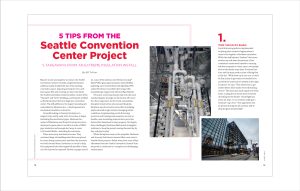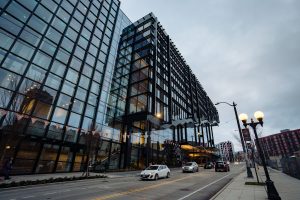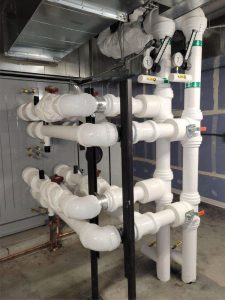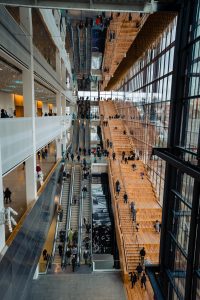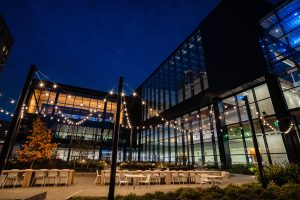5 Tips from the Seattle Convention Center Project
5 Takeaways from an Extreme Insulation Install
Massive in size and majestic in stature, the Seattle Convention Center’s recently completed Summit addition nearly doubled the size of the existing convention space. Imposing a footprint of 1.5 million square feet and covering an entire city block, the Seattle Convention Center facilities consist of the “Summit” and “Arch” buildings, and Summit is billed as North America’s first true high-rise convention center. The $2B addition is the largest insulating job undertaken by Heckman Inc., a fourth-generation mechanical insulation contractor.
Groundbreaking on Summit took place in August 2018, and by early 2020 it was time to begin insulating the mechanical pipes. Heckman Inc. owner Jeff Heckman and Project Foreman Jose Arce developed a game plan to install 19.5 miles of HVAC pipe insulation and enough duct wrap to cover 9.75 football fields—including the end zones.
There were many mechanical rooms. They contained huge air handling units that were placed by crane during construction and then the structure was built around them. Insulation is crucial to help this equipment have the longest life possible as they can’t be removed or replaced. Shown on pages 19 and 20, some of the systems used Owens Corning® SSL II® fiber glass pipe insulation with ASJ Max jacketing, and covered them with Speedline PVC and/or No Sweat reuseable valve wraps with insulated pipe supports by Thermal Pipe Shields.
Of course, every team knows that even the most calculated game strategy can be thrown off course by a fierce opponent. As the Covid-19 pandemic disrupted construction sites around the globe, Heckman and Arce had to revise their insulating playbook amid tough and ever-changing jobsite conditions. Implementing social distancing protocols and training team members on how to handle a new insulating material were just a few factors that threatened to slow progress. Yet despite these challenges, Heckman Mechanical strategized solutions to keep the project moving forward day by day, and play by play.
While disruptions may not be enjoyable, Heckman and Arce say that lessons learned often carry over to benefit future projects. Below, they share some of key takeaways from the Seattle Convention Center’s Summit project, conducted in a complex and challenging environment.
1. Think Outside the Basket
Social distancing policies implemented in Spring 2020 created a logjam when it came to the logistics of workers on jobsites. While the staff elevator “baskets” that move workers up and down the exterior of the convention center were limited to carrying just five occupants at a time, up to 1,000 people were at the jobsite some days. Foreman Jose Arce and his team made a point of being first at the site. “We’d show up at 2:30 a.m. so we’d be first in line to get where we needed to be and with the materials we needed at the right locations,” he says. “This allowed us to get started while other trades were still waiting in line.” The team also made ample use of the stairs, scaling the 13 stories by foot instead of waiting for the basket. “Each flight was about 40 steps, so our workers really got a workout,” says Arce. “One apprentice lost 30 pounds during the job and was able to drop his gym membership!”
2. Compress Instead of Cut
The mechanical pipes in the Seattle Convention Center include steel pipes, copper pipes, and a lot of ProPress fittings. Arce says that the type of insulating material used helped keep things efficient on the jobsite. “Some insulations are really rigid, but Owens Corning® SSL II® with ASJ Max fiberglass pipe insulation can be compressed to fit around the pipes. There was no need to hollow the material out for ProPress or valves,” he says. From a timing perspective, Arce says that hollowing out insulation can take three times longer than using an insulation that can be compressed to precisely fit the pipe. “It all comes down to compressibility for pipes 2” or smaller,” he says.
3. Craft with Pride
An insulating material’s ability to deliver thermal performance will always be the priority when insulating mechanical pipes, but Arce says craftsmen also take pride in the appearance of their job. “Everyone gawks at the exterior of the Seattle Convention Center, but the mechanical room is a really beautiful place,” he says. The Owens Corning® SSL II® with ASJ Max fiberglass pipe insulation installed on pipes in the Seattle Convention Center’s Summit is equipped with a self-sealing system and designed to fit over larger pipes and coverings without wrinkling. Getting workers to select a material with a different fastening system was a challenge at first, but once the crew got a feel for the insulation and the clean, wrinkle-free look it presented, they loved working with the product.
4. Communicate with Distributor Partners
During a period when supply chains saw unprecedented disruption, Heckman says logistics flowed smoothly on the Summit addition. “We stayed in communication with Bay Insulation and coordinated a schedule for a truckload delivery to the jobsite every Wednesday and Friday, with at least 20 boxes of material per trip,” he says. And if the team got ahead of schedule, the distributor would bring in an “emergency truck” as needed.
5. Bring Food
Heckman and Arce say there is no substitute for taking care of people on the jobsite, including those working on other trades for long stretches of time. Arce recalls an electrician who was on site from the preconstruction phase through completion—7 years. “Long projects can be repetitive, and a lackadaisical attitude can set in,” says Arce. Keeping a positive attitude, along with making surprise tamale deliveries on the jobsite, not only fostered goodwill and camaraderie but made workers eager to cooperate. “Just a little food can open doors,” says Arce.
Aside from practical insights like selecting an efficient and easy-to-work-with insulation, supporting workers’ pride in their craft, and communicating with partners, Heckman says that taking on the challenge of a super-sized project during a global pandemic was a reminder of how teamwork can make all the difference. “If anything has solidified our company, it was knowing that we did it with a team of just four insulators on most days,” he says. While successfully completing the massive installation was a win in itself, Heckman says the project was an opportunity for the team to step into a new arena of competition. Remarking on the project, he said, “After Heckman Inc. successfully completed the Seattle Convention Center with a high level of craftsmanship and efficiency, most mechanical contractors would consider Heckman Inc. capable of tackling any size project. The Seattle Convention Center truly put Heckman, Inc. on a whole new level.”

